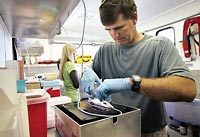forum
library
tutorial
contact

Biologists Tag Smolts, Fish for Data
on Why Fall Chinook Linger
by Andrew Sirocchi, Tri-City Herald
The Seattle Times, October 8, 2007
|
the film forum library tutorial contact |

|
Biologists Tag Smolts, Fish for Data
by Andrew Sirocchi, Tri-City Herald
|
 LITTLE GOOSE DAM, Snake River -- Geoff McMichael's operating table is a cramped, foam-filled metal box.
LITTLE GOOSE DAM, Snake River -- Geoff McMichael's operating table is a cramped, foam-filled metal box.
His patients are mere inches long, but in his hands surgery takes only minutes -- cut a tiny slit near the abdomen, insert two tiny devices and close up with two silk sutures.
These are healthy youngsters -- among the hundreds of thousands of endangered fall chinook salmon smolts that are supposed to head down the Snake River on a 400-mile trip to the mouth of the Columbia River and into the Pacific Ocean.
In late September, with the smolt migration nearing its end, tagging salmon is light work in the fish facility at Little Goose Dam, near the small community of Starbuck in Columbia County. Only about 20 fish a day are being implanted with acoustic transmitters.
They will tell biologists like McMichael, of Pacific Northwest National Laboratory (PNNL), how the young fish are behaving as they reach Lower Monumental Dam, the next dam downstream from Little Goose.
PNNL scientists are tagging about 25,000 fish for all Columbia River studies this year, but it's this small sample of about 2,000 late-running smolts that might tell the Army Corps of Engineers and biologists with other agencies why certain chinook have been stalling at Lower Monumental and never completing the trip downstream.
The reservoir, or at least conditions in it, are a potential culprit.
In 2006, a pilot program using acoustic tags that incorporate the same technology used in cellphones gave scientists a better idea of the smolts' behavior.
In June, 85 to 90 percent of the tagged fish shot straight downriver heading for the ocean. But by the first few weeks of July, 50 percent were lagging behind in the Lower Monumental reservoir.
From mid-August to September, 80 percent of the smolts quit moving through the system, and by the time the project ended, 44 percent of the 1,949 chinook tagged never crossed the dam.
"We didn't know if they died or stopped and fed," McMichael said. "And if there's a significant amount of chinook that are stopping, how do we improve that?"
Researchers found the fish started lagging at an increased rate at the same time as layers of increasingly different water temperatures were building up within the reservoir.
Warmer water collected at the top, and not just near the dam but well into the lower reservoir. Cool water released from Dworshak Dam flowed under the warmer water in the reservoir but didn't mix well.
McMichael said smolts appeared to stall where the two layers come together.
If the fish aren't moving because of circulation within the reservoir, a new type of fish-passage system being installed at Lower Monumental Dam in November could be the solution.
Called a removable spillway weir, the system allows fish to pass through the dam along the surface water -- up to 10 to 13 feet deep -- instead of requiring them to dive deep below to find a way downstream. Corps spokesman Rick Haverinen said the fish-passage system will be the third of its kind installed on Columbia and Snake river dams.
The key to helping the fish is in gathering better data to identify what smolts are doing and why.
The smolts McMichael and other scientists were tagging last month had been feeding in the rivers longer and are twice as large as the chinook that were tagged earlier in the summer. That could mean the fish have a better chance of surviving, but only if they make it past the dams and to the ocean.
The group's goal was to tag 2,800 smolts, but with about 1,700 tagged so far and most of the run already past, it looks unlikely the goal will be met.
PNNL also was contracted to tag 200 predator fish with similar devices this year to better track how many smolts are being eaten by bass and catfish.
It will be about 18 months before all the data can provide a big picture of what's happening in the reservoir. The corps still will need to determine how the removable spillway weir affects the run in 2008 before it can draw conclusions about why so many smolts are stopping above Lower Monumental Dam.
learn more on topics covered in the film
see the video
read the script
learn the songs
discussion forum
